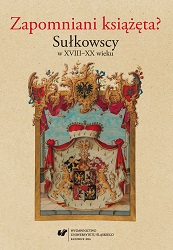Pod dwugłowym orłem. Sułkowscy w armii Habsburgów w latach 1746–1918
The double-headed eagle coat of arms. The Sułkowski in the Habsburg army in the years 1746–c1918
Author(s): Piotr Kenig
Subject(s): History
Published by: Wydawnictwo Uniwersytetu Śląskiego
Summary/Abstract: In 1752 a Polish magnate, Aleksander Józef Sułkowski, purchased Bielsko with the adjacent areas, located in Austrian Silesia, and he received a princely title from Maria Theresa and her husband, emperor Franz Stefan. Thenceforth, for more than 160 years, until the fallof the Danube monarchy in 1918, almost all of his male descendants of the Bielsko line served in the Imperial-Royal army of the Habsburgs. The article gathers the scattered pieces of information about this heretofore underexplored aspect of the history of the family. The scant pieces of information about the Austrian armed forces, especially about the wars and campaigns in which the said forces participated, as well as the changes and the reorganisation to which they were subject with the course of time enable us to understand the peculiar nature of service in the particular periods. Some remarks were devoted to the regiments in which the Sułkowski served, both the particular owners of Bielsko estates as well as the sons and grandsons of the late prince Ludwik who lived in other parts of the Danube monarchy, and after its fall – in the so-called successor countries: Austria, Jugoslavia and Hungary. The present overview may become a starting point for an in-depth pursuit of sources, especially in the Viennese Kriegsarchiv and in the Central Military Archive (Centralne Archiwum Wojskowe) in Warsaw.The article presents the figures of 18 people, representing six generations of the family. During the Seven Years’ War the senior of the family, Aleksander Józef Sułkowski (1695–1762), supported Austria, and three of his sons served in the Habsburg army. For August Kazimierz (1729–1786) this was a short stint, but Aleksander Antoni (1730–1786) went on to become an imperial general after some years. Franciszek (1733–1812) soon turned to service with Russia, then to service with Poland, and then he and his successors embraced Austria. He finished his career in the rank of a general. Also Aleksander Józef ’s nephew, count Teodor Sułkowski, whose history was linked with Bielsko and the princely cousins, served under the black and yellow banner.Franciszek’s sons participated in the wars of the Napoleonic period: Aleksander Józef (1775–1804), who died prematurely, an officer of great promise, and the rebellious Jan Nepomucen (1777–1832). The latter became a supporter of Bonaparte in the years 1807-1809. This decision cost him his life; he died in the Terezin stronghold as a political prisoner. His successors: Ludwik (1814–1879) and Maksymilian (1816–1848), were in the imperial army in the 1830s; they supported the cause of the revolution during the Spring of Nations; the elder brother, who faced the threat of being arrested, remained abroad for a long time, and died a soldier’s death in Vienna.During the last half-century of the existence of the imperial army six sons and three grandsons of Ludwik Sułkowski served in it. Józef Maria (1848–1920) was briefly a cadet in the 1st Uhlan Regiment; his half brothers were officers in the 6th Hussar Regiment. Ludwik (1874–1881), a colonel, died at a young age. Aleksander Edward (1856–1929) retired in 1894 in the rank of a captain of horse (rotmistrz), then he assumed control of the family estate in Bielsko. Stanisław (1862–1940), since 1888 a part of the reserve of the regiment, received a pension in 1903. He was a second lieutenant. Wiktor (1870–1945), who was a part of the reserve of the regiment since 1894, was mobilised in 1914, manifested valour on the frontline and was promoted to the rank of a captain of horse. Edgar (1868–1954) was the one who stayed in the army for the longest period of time; in 1892 he was transferred to the 9th Hussar Regiment. Since 1913 he was commander of the division; during the First World War he fought inter alia at Limanowa. He was decorated many times. He finished his service in the rank of a lieutenant commander.Stanisław’s elder son, whose name was also Stanisław (1886–1963), an officer of the 2nd Dragoon Regiment, left the army before 1916. The younger son, Aleksander (1888–1970), fought in the 5th Dragoon Regiment. Their cousin, Aleksander Edward’s son, Aleksander Ludwik (1893–1956), joined the 4th Uhlan Regiment as a volunteer; in 1916 he participated in bitter fights at the Dniester River, where he displayed valour and was seriously wounded. After the war ended, he became of resident of Bielsko. An officer of the reserve of the cavalry of the Polish Army, in the years 1929–1945 he was the last inheritor of the Bielsko estate.
Book: Zapomniani książęta? Sułkowscy w XVIII–XX wieku
- Page Range: 165-194
- Page Count: 30
- Publication Year: 2016
- Language: Polish
- Content File-PDF

